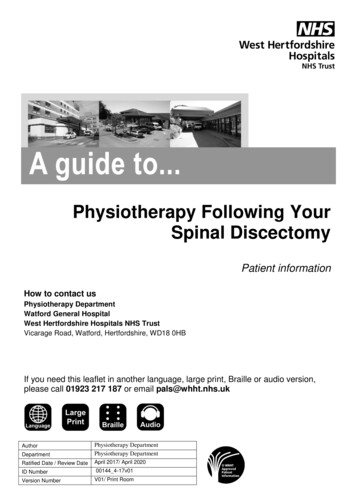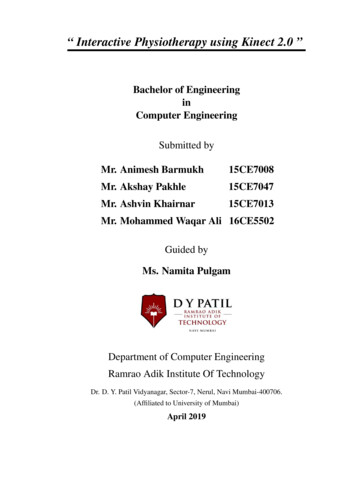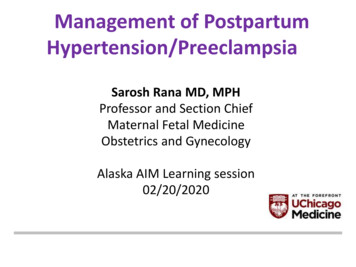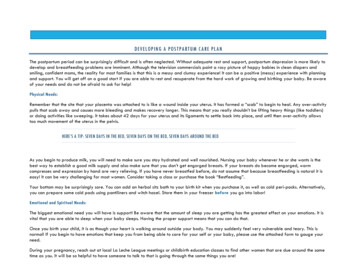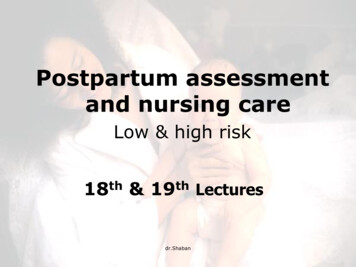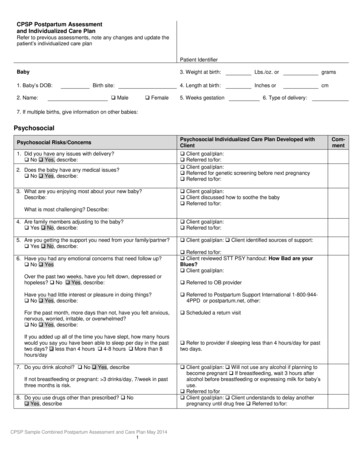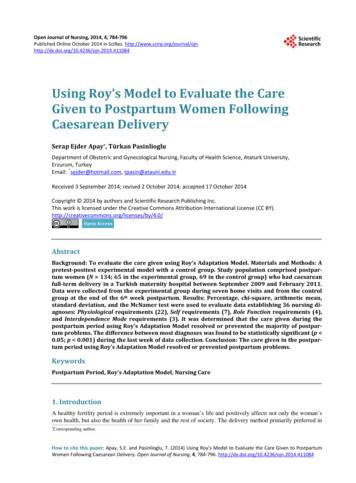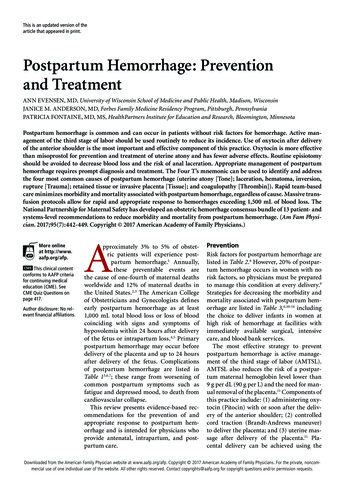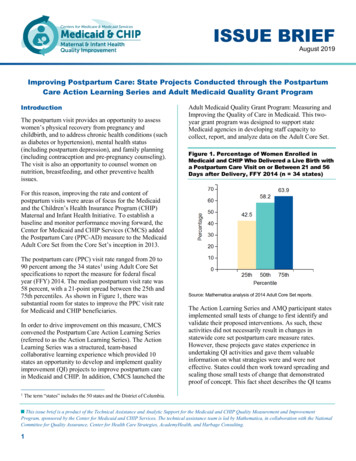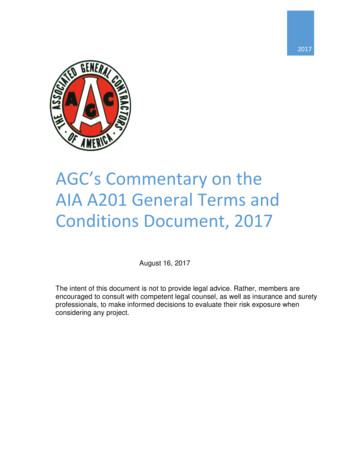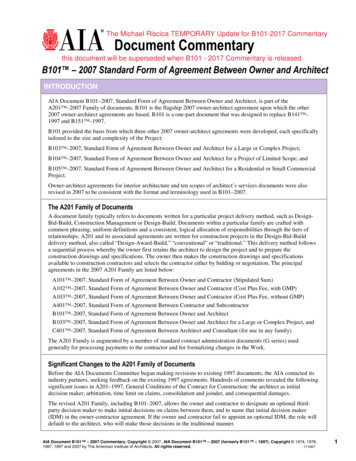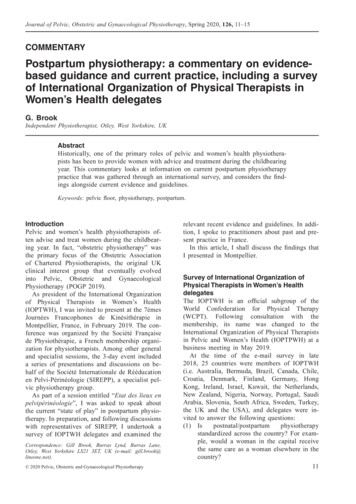
Transcription
Journal of Pelvic, Obstetric and Gynaecological Physiotherapy, Spring 2020, 126, 11–15COMMENTARYPostpartum physiotherapy: a commentary on evidence- based guidance and current practice, including a surveyof International Organization of Physical Therapists inWomen’s Health delegatesG. BrookIndependent Physiotherapist, Otley, West Yorkshire, UKAbstractHistorically, one of the primary roles of pelvic and women’s health physiotherapists has been to provide women with advice and treatment during the childbearingyear. This commentary looks at information on current postpartum physiotherapypractice that was gathered through an international survey, and considers the findings alongside current evidence and guidelines.Keywords: pelvic floor, physiotherapy, postpartum.IntroductionPelvic and women’s health physiotherapists often advise and treat women during the childbearing year. In fact, “obstetric physiotherapy” wasthe primary focus of the Obstetric Associationof Chartered Physiotherapists, the original UKclinical interest group that eventually evolvedinto Pelvic, Obstetric and GynaecologicalPhysiotherapy (POGP 2019).As president of the International Organizationof Physical Therapists in Women’s Health(IOPTWH), I was invited to present at the 7èmesJournées Francophones de Kinésithérapie inMontpellier, France, in February 2019. The conference was organized by the Société Françaisede Physiothérapie, a French membership organization for physiotherapists. Among other generaland specialist sessions, the 3- day event includeda series of presentations and discussions on behalf of the Société Internationale de Rééducationen Pelvi- Périnéologie (SIREPP), a specialist pelvic physiotherapy group.As part of a session entitled “Etat des lieux enpelvipérinéologie”, I was asked to speak aboutthe current “state of play” in postpartum physio therapy. In preparation, and following discussionswith representatives of SIREPP, I undertook asurvey of IOPTWH delegates and examined theCorrespondence: Gill Brook, Burras Lynd, Burras Lane,Otley, West Yorkshire LS21 3ET, UK (e- mail: gill.brook@lineone.net). 2020 Pelvic, Obstetric and Gynaecological Physiotherapyrelevant recent evidence and guidelines. In addition, I spoke to practitioners about past and present practice in France.In this article, I shall discuss the findings thatI presented in Montpellier.Survey of International Organization ofPhysical Therapists in Women’s HealthdelegatesThe IOPTWH is an official subgroup of theWorld Confederation for Physical Therapy(WCPT). Following consultation with themembership, its name was changed to theInternational Organization of Physical Therapistsin Pelvic and Women’s Health (IOPTPWH) at abusiness meeting in May 2019.At the time of the e- mail survey in late2018, 25 countries were members of IOPTWH(i.e. Australia, Bermuda, Brazil, Canada, Chile,Croatia, Denmark, Finland, Germany, HongKong, Ireland, Israel, Kuwait, the Netherlands,New Zealand, Nigeria, Norway, Portugal, SaudiArabia, Slovenia, South Africa, Sweden, Turkey,the UK and the USA), and delegates were invited to answer the following questions:(1) Ispostnatal/postpartumphysiotherapystand ardized across the country? For example, would a woman in the capital receivethe same care as a woman elsewhere in thecountry?11
G. Brook(2) If there is standardized care, what does itinclude?(3) Who pays for the treatment?Contrary to normal practice, I will start withthe limitations of this survey because I feel thatthese should be taken into account when considering the findings. This was a non- scientificsnapshot of practice in 25 countries, all ofwhich have a pelvic/women’s health physiotherapy organization. Therefore, the results cannotbe generalized to practice globally, particularlyin countries where physiotherapy services areless well established if, indeed, these exist atall. The survey was answered by, at most, a fewphysiotherapists; in many cases, just one personwas responsible for the replies. Undoubtedly,there will be wide variations in practice within some countries. The questions were broadand lacked clarity, and the answers that werereceived varied from a few words to more- extensive information and detail. Lastly, the survey was only available in English, which is theofficial language of WCPT. This may have limited the answers from some countries.Is postnatal/postpartum physiotherapy stand ardized across the country? For example,would a woman in the capital receive the samecare as a woman elsewhere in the country?Forty- eight per cent of the responders statedthat there is no standardized national approach.Only two said that the aim in their countries isto see every woman postpartum before she isdischarged from hospital. In contrast, more thanthree- quarters of delegates said that women arenot seen routinely. Twenty per cent said thatonly women who were at particular risk of apelvic floor dysfunction (e.g. following obstetric anal sphincter injury), or those who werealready symptomatic, would be seen. Some delegates highlighted variations within their country, with one in five saying that women in ruralareas were less likely to see a physiotherapist,while others stated that there is a difference between public and private services.Where physiotherapy is not offered, optionsmight include written information, advice froma midwife or nurse, or in at least one country,referral for extracorporeal magnetic innervation.If there is standardized care, what does itinclude?Some responders mentioned group sessions forwomen postpartum, while others saw women12on a one- to- one basis one or more times beforethey were discharged from hospital. The intervention itself varied greatly, but the followingwere all mentioned by at least one delegate:Education, advice and exercises:anatomy and physiology;leaflets and other resources; andprevention of dysfunctions.Pelvic floor muscles (PFMs):activity;function; andrehabilitation (with or without examination,electromyography and dynamic ultrasound).Abdominal musclesactivation of the abdominal capsule;deep abdominal muscle exercises;examination of the abdomen; anddiastasis recti abdominis.Breathing pattern.Posture and movement:infant feeding; andhandling the baby.Perineal care.Caesarean section wound/scar care.Bladder and bowel care (e.g. constipation).Fatigue.Depression.General activity/fitness.Baby massage and stimulation. In countries where women were only seen ifthey were symptomatic, the following might bereasons for referral:urinary dysfunction;anorectal dysfunction;pelvic organ prolapse (POP);sexual dysfunction;diastasis recti abdominis;pain (e.g. low back, pelvic girdle, perineumand incision); andbreastfeeding difficulties. Three delegates spoke of following nationalguidelines, local protocols or a screening tool.Who pays for the treatment?Free postpartum physiotherapy was available in44% of the countries surveyed. Women couldaccess private treatment in most or all countries;this was either covered by insurance, subsidizedby the state (24%) or self- funded. Several delegates said that women might choose privatephysiotherapy to avoid long waiting lists withinthe public health system. 2020 Pelvic, Obstetric and Gynaecological Physiotherapy
Postpartum physiotherapySummary of the findingsWomen were not seen routinely by a physio therapist following childbirth in the majority ofthe 25 IOPTWH member countries. Few saw aphysiotherapist until at least 6 weeks postpartum, and any national standardization of carewas rare. No free care was available in morethan half the countries surveyed.Postpartum physiotherapy: currentpractice and evidence- based guidanceIn an earlier study, Bourcier et al. (2017) undertook an international survey of pelvic floor rehabilitation (PFR) after childbirth, gathering 51responses from 28 countries. With 21 questionson five topics, this study was more comprehensive than the present one, but the findingswere not dissimilar: it was most common forPFR to start 6 weeks postpartum, and only forsymptomatic women; the number of treatmentsmight be limited and undertaken by a suitablyskilled physiotherapist; therapy would normallyinclude individualized PFM training (PFMT)with a home exercise programme (biofeedbackor neuro muscular electrical stimulation mightbe included as a second- line intervention); andwomen often had to contribute to the cost oftheir physiotherapy. Bourcier et al. (2017) concluded that there is currently no clear guidanceon new mothers’ recovery and rehabilitation,and that this should be developed. They also argued that a multidisciplinary strategy is neededduring and after a woman’s first pregnancy.Routine postpartum PFR was established inFrance more than 30 years ago (Bourcier et al.2017), and anecdotally, has long been the envyof many physiotherapists in other countries.Funded under the government’s healthcare plan,women have been referred by their obstetrician,and receive 10 sessions of therapy delivered bya physiotherapist or midwife (Bourcier et al.2017). However, practice in France is changing.Sénat et al. (2016) produced postpartum practice guidelines on behalf of the Collège Nationaldes Gynécologues et Obstétriciens Français(CNGOF; the French College of Gynaecologistsand Obstetricians). These authors undertook asystematic literature review of a range of relevant subjects, including postpartum PFR, andconcluded (by professional consensus, in the absence of irrefutable scientific evidence) that pelvic floor rehabilitation in asymptomatic womento prevent urinary or anal incontinence in themedium or long term is not recommended. They 2020 Pelvic, Obstetric and Gynaecological Physiotherapyalso advised against PFR to prevent or treat POPor dyspareunia, but recommended it for anal incontinence. On the basis of very robust evidence,PFMT was recommended to treat urinary incontinence persisting at 12 weeks postpartum. Sénatet al. (2016) listed no physiotherapists amongtheir steering committee, working group or peerreviewers. However, they did cite Deffieux et al.(2015), who included physiotherapists among theauthors of their guidelines on postpartum PFMTand abdominal rehabilitation. Based on a systematic review, they concluded that PFM therapyshould be recommended for postpartum urinaryor anal incontinence persisting 3 months afterdelivery.Woodley et al. (2017) undertook a systematicreview on behalf of the Cochrane Library. Basedon the evidence from 38 trials, they concludedthat it is uncertain whether a population- basedapproach for delivering postnatal PFMT is effective in reducing urinary incontinence. Dumoulinet al. (2017) reached a similar conclusion, andsuggested that health providers should carefullyconsider the cost–benefit ratios of population- based approaches to antepartum or postpartumPFMT taught by a healthcare professional.CommentGuidelines by eminent authors based on systematic reviews of the available literature do notsupport a “blanket” approach to postpartum PFMrehabilitation by physiotherapists or other healthcare professionals. Both the present IOPTWHinternational survey and that of Bourcier et al.(2017) suggest that this is already current practice in many countries. Although two IOPTWHdelegates said that physiotherapists aim to seeevery woman before she is discharged fromhospital postpartum, many responders were concerned that current service provision could noteven ensure that symptomatic or at- risk womenare seen in a timely manner, be that as inpatients or outpatients.As is often the case, authors recommendedfurther research (Dumoulin et al. 2017; Woodleyet al. 2017). Three out of four recommendationson PFR within the postpartum practice guidelinesfor clinical practice from the CNGOF (Sénatet al. 2016) were based on consensus and expertopinion, and Deffieux et al. (2015) identified alack of randomized trials to inform practice.Based on the current evidence, should those ofus who might aspire to see every woman postpartum – or think that is the ideal – change our13
G. Brookview? In a recent prospective study of 382 women, Neels et al. (2018) found that 57% were notable to undertake an isolated PFM contractionwhen observed in the first few days postpartum;common faults included a concomitant contraction of the rectus abdominis, gluteal or hip adductor muscles, a pelvic tilt, and breath- holdingor straining. After verbal feedback, this droppedto 3%. Might these findings justify one- to- oneassessment and advice for women postpartum?In addition, the IOPTWH survey highlighted abroader role internationally for women’s healthphysiotherapists during the postpartum period(see p. 12). Although such physiotherapy interventions (e.g. diastasis recti abdominis, postureand a return to fitness activities) were not thefocus of my attention before the Montpellier conference, these are worthy of further consideration.Thankfully, whatever our precise role, the contribution of physiotherapy postpartum is recognized outside our own profession. In a document on “Optimizing postpartum care” (ACOG2018), the American College of Obstetriciansand Gynecologists recommends that women whoare experiencing urinary or faecal incontinenceare referred to a physical therapist. A joint RoyalCollege of Midwives and Chartered Society ofPhysiotherapy statement on PFM exercises (RCM& CSP 2017) recommends that: there should bea referral pathway to specialist physiotherapy forat- risk or symptomatic women; midwives mustbe trained to provide women with accurate advice and effective support; and on a local level,physiotherapists should offer PFM training tomidwives.A National Health Service (NHS) improvementproject in 2017–2018 looked at safe, sustainableand productive staffing in many different specialties, including maternity (NHS Improvement2018). Physiotherapists were recognized as partof the multidisciplinary team, and the resourcesincluded evidence- based recommendations ontheir role during pregnancy and postpartum. Inaddition to direct patient contact, this includedphysiotherapy- led education for midwives andmidwifery students. Most recently, The NHSLong Term Plan (NHS 2019) pledges improvedaccess to postnatal physiotherapy to supportwomen who need it to recover from birth, recognizing the effectiveness and cost- effectivenessof our interventions.This is an optimistic note on which to finish.Only time will tell if these aspirations become areality, but I am confident that pelvic and women’s health physiotherapists will do their utmost14to ensure that women receive the postpartumcare that they deserve.ReferencesAmerican College of Obstetricians and Gynecologists(ACOG) (2018) ACOG Committee Opinion No. 736:optimizing postpartum care. Obstetrics and Gynecology131 (5), e140–e150.Bourcier A., Dmochowski R., Cervigni M. & Haab F. (2017)International survey on pelvic floor rehabilitation afterchildbirth. [Abstract.] [WWW document.] URL dfDeffieux X., Vieillefosse S., Billecocq S., et al. (2015)Rééducation périnéale et abdominale dans le post- partum: recommandations. [Postpartum pelvic floor muscle training and abdominal rehabilitation: guidelines.]Journal de Gynécologie Obstétrique et Biologie de laReproduction 44 (10), 1141–1146.Dumoulin C., Adewuyi T., Bradley C., et al. (2017) Adultconservative management. In: Incontinence, 6th edn (edsP. Abrams, L. Cardozo, A. Wagg & A. Wein), pp. 1443–1628. International Continence Society, Bristol.National Health Service (NHS) (2018) Safe, Sustainableand Productive Staffing. An Improvement Resource forMaternity: Appendices. [WWW document.] URL https://improvement.nhs.uk/documents/1354/Safe StaffingMaternity Appendices proofed.pdfNational Health Service (NHS) (2019) The NHS Long TermPlan. [WWW document.] URL https://www.longtermplan.nhs.uk/Neels H., De Wachter S., Wyndaele J.- J., Van Aggelpoel T.& Vermandel A. (2018) Common errors made in attemptto contract the pelvic floor muscles in women early after delivery: a prospective observational study. EuropeanJournal of Obstetrics & Gynecology and ReproductiveBiology 220 (January), 113–117.Pelvic, Obstetric and Gynaecological Physiotherapy(POGP) (2019) About POGP. [WWW document.] URLhttps://pogp.csp.org.uk/content/about- pogpRoyal College of Midwives & Chartered Society ofPhysiotherapy (RCM & CSP) (2017) RCM/CSP JointStatement on Pelvic Floor Muscle Exercise: ImprovingHealth Outcomes for Women Following Pregnancy andBirth. [WWW document.] URL https://www.rcm.org.uk/media/2307/rcmcsp- j oint- s tatement- o n- p elvic- f loor- muscle- exercises 4.pdfSénat M.- V., Sentilhes L., Battut A., et al. (2016)Postpartum practice: guidelines for clinical practice fromthe French College of Gynaecologists and Obstetricians(CNGOF). European Journal of Obstetrics & Gynecologyand Reproductive Biology 202 (July), 1–8.Woodley S. J., Boyle R., Cody J. D., Mørkved S. & Hay- Smith E. J. C. (2017) Pelvic floor muscle training forprevention and treatment of urinary and faecal incontinence in antenatal and postnatal women. CochraneDatabase of Systematic Reviews, Issue 12. Art. No.:CD007471. DOI: 10.1002/14651858.CD007471.pub3.Gill Brook is a semi- retired women’s healthphysio therapist. She is the immediate pastpresident of IOPTWH, an official subgroup ofthe WCPT. Until recently, Gill was a tutor forPOGP, and a clinical tutor for the University 2020 Pelvic, Obstetric and Gynaecological Physiotherapy
Postpartum physiotherapyof Bradford’s Physiotherapy in Women’s Healthpostgraduate certificate programme. She hasa particular interest in the development of 2020 Pelvic, Obstetric and Gynaecological Physiotherapywomen’s health and pelvic physiotherapy services in countries where the specialty is emergingor does not yet exist.15
Physical Therapists in Women’s Health delegates The IOPTWH is an official subgroup of the World Confederation for Physical Therapy (WCPT). Following consultation with the membership, its name was changed to the International Organization of Physical Therapists in Pelvic and Women’s Health (IOPTPWH) at a business meeting in May 2019.
